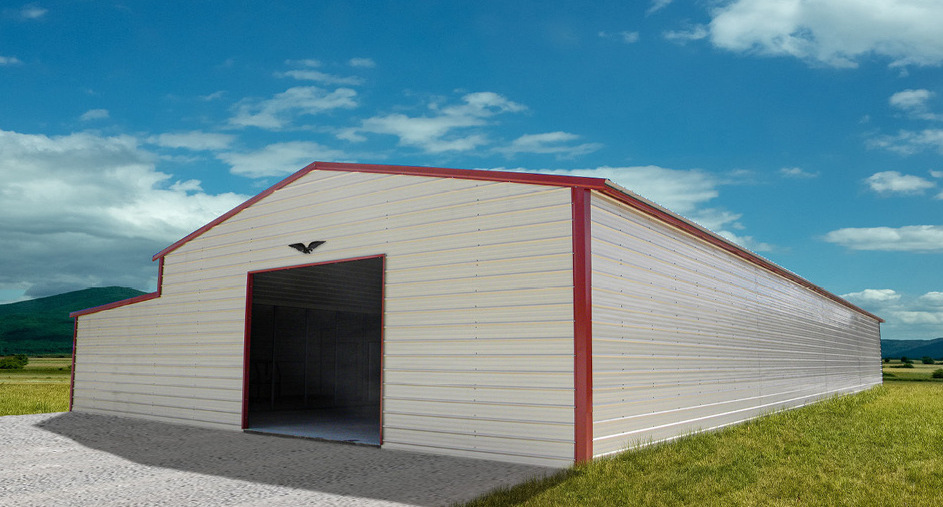Most ranchers and other livestock owners default to housing their animals in wooden structures. This is expected, as wooden barns have been used in agricultural work for hundreds, perhaps thousands, of years. But many livestock owners are beginning to wonder if wood is still the gold standard for animal housing, especially when compared to metal barns.
Housing animals in a metal barn is a much safer choice than keeping them in a wooden structure. Metal is much stronger and more durable than wood and offers greater protection from predators and environmental effects. It will also be cheaper in the long run, since it will last longer against environmental degradation.
Few people are aware of just how advantageous metal barns can be when looking for suitable protection for livestock. However, when comparing the metal structures directly to wooden buildings, the benefits become quite clear. Read on to learn some of the key ways in which a metal structure can offer safety for your livestock.
Metal Barns Have Fewer Pathogenic Vulnerabilities

Wooden barns are much more vulnerable to pathogens when compared to metal. Moisture from the animals’ waste can quickly degrade the wood’s integrity, significantly increasing the chances of pests infesting the structure.
Some of the most widespread wood-destroying insects in the United States include:
- Beetles
- Ants
- Termites
- Bees
- Wasps
These insects pose a severe danger to many facets of life. Your animals’ lives are directly threatened, as their living space is actively being compromised. If any critical components of the barn were to weaken or break down too much, the entire building could collapse onto your livestock.
Wasps and ants are aggressive little critters. If they were to get a hold of any of your animals, they could do a great deal of damage. You are also introduced to the same threat when you enter the barn to work or check on your livestock. This presents a safety hazard to yourself and any employees working on the property (especially if anyone is allergic to these insects). (Source: Utah Department of Agriculture and Food)
Metal Barns Can Better Resist Environmental Pressures
Wood is also vulnerable to becoming overtaken by fungal and bacterial outbreaks. Many types of fungi and bacteria are drawn to moisture-ridden wood in the same way that insects are attracted to it. Unfortunately, these infestations can establish themselves and spread rapidly. They’re also quite challenging to get rid of, and will stick around, continuing to degrade the wood for years to come.
Some of the most common wood-decaying conditions that can arise from these infestations include (Source: SUNY College of Environmental Science and Forestry):
- Brown rot: Causes the rapid weakening of wooden structures
- Cubical rot
- Cubical pocket rot
- Dry rot
- Building rot fungus
- White rot: Another condition causing significant losses of strength
- Pocket rot
- Stringy rot
- Spongy rot
- Soft rot: Works much slower than the former two but still weakens the wood. It also causes surface erosion of the wooden structure.
Metal is impervious to these types of decay since it is not made up of the lignin, cellulose, and other cellular components that comprise wood. It is waterproof, so excessive absorption of water is not a concern. This type of resistance to pathogens is critical to your animal’s health and safety, especially for young, medically vulnerable animals that are being welcomed during calving and lambing season.
How Metal Barns Can Protect Your Livestock from Barn Fires
A metal barn would also much more efficiently defend your animals against devastating barn fires. This is a heartbreaking accident that has plagued many ranches and farms over the years. As of January of this year, approximately 2 million animals have been killed in these fires since 2017. In 2019 alone, the estimated number of livestock that lost their lives this way amounted to 469,000. (Source: News Break)
You do not have to settle for such vulnerability. Metal will not go up in flames the way wood does. This trait will not only decrease the chances of a fire ever happening on your property, but it will buy you time to evacuate the facility if combustion does occur for some reason.
Note: This does not mean that metal cannot burn. Its burning point just happens to be much higher than wood, which can be anywhere between 190-260֯C. Most metals will only begin to melt – a point that comes far before potential ignition – anywhere from the low 300 degrees to thousands. Steel, for example, hits its melting point at 1100-1600֯. (Source: T.C. Forensic)
Metal Barns as a Defense Against Predators
With a metal barn, your animals will be much better protected from potential predators. Instead of crossing your fingers and hoping no determined coyote or hungry snake gets through the wooden planks and chicken wire, you can rest assured that your livestock is safe in a metal barn. Animals can’t dig through metal!
Every year across the U.S., hundreds of thousands of livestock are taken by predators. These losses can result in devastating impacts on your quality of life, as this dramatically reduces food availability and ripples into your financial stability. The financial investment you placed into your barn and animals could be lost in the blink of an eye. Fortunately, with a metal structure, you can defend against such problems. (Source: United States Department of Agriculture)
In Conclusion
Metal barns offer much more protection to your livestock than a wooden barn ever could. They are far more resistant to environmental pressures, whether they be insect infestations, mold and mildew growth, or extreme weather events. Though wooden barns have a historical place in livestock ownership, current times beckon ranchers and others to choose metal as their go-to material for animal housing.


